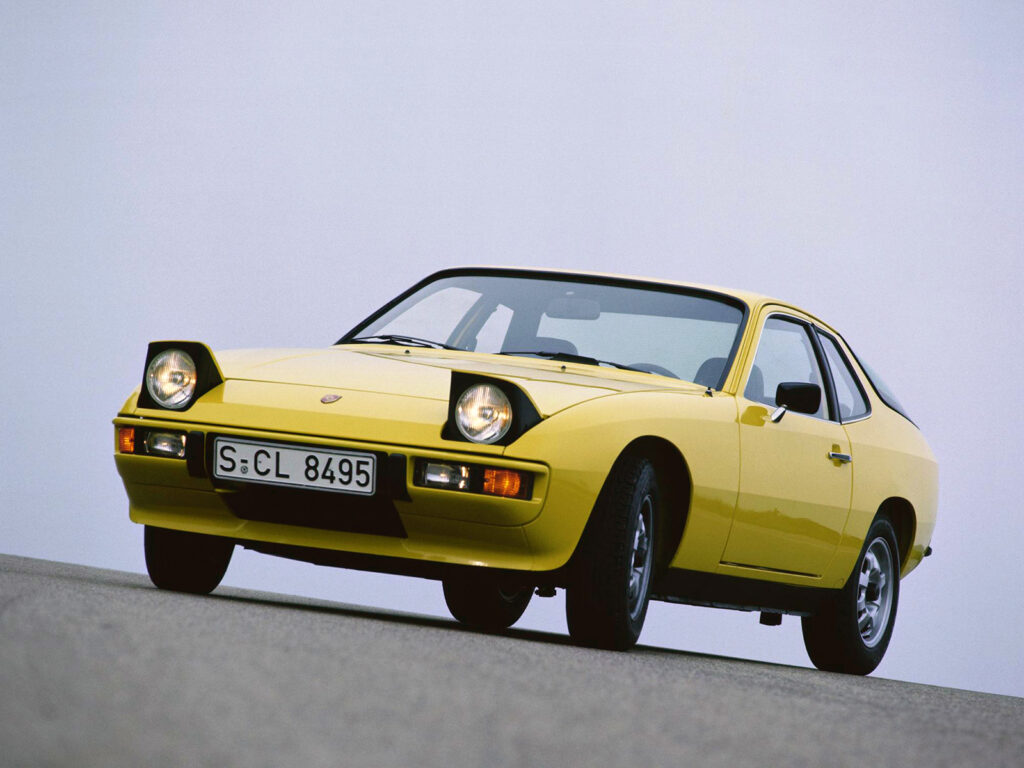924
(1976 – 1985)
In the early 1970’s Porsche was approached by the VW Audi group to design a flagship sports car for their marque. The idea for the 924 was born.
The 924 revived an idea that Porsche had not used since the 356 – to produce a car with appeal to the enthusiast from run of the mill parts at an affordable price. In this case Porsche made its selection from the Volkswagen & Audi parts bins. The 924 was significant for another reason, it was the first of a new generation of front-engined, water-cooled Porsches that would soon unleash the 928 and see the 924 evolve into the 944 and eventually the 968.
Despite originating from a Volkswagen design the 924 has been recognised as a truly exceptional sports car. They are economical tourers, with “adequate” acceleration and capable of considerable speeds. Despite having solid front discs and drums at the rear, the braking is quite good, and having a fifty fifty weight split provides outstanding handling, allowing many a 924 with a skilled driver, to take on the much more powerful 911’s at track events.
With rear, if somewhat small, seats and practical luggage space, the car is ideally suited as a first Porsche for those on tight budgets. Being inexpensive, even quite poor cars will find buyers in the private market. So most cars change hands privately and cheaply or are in excellent condition, but are expensive.
The engine in the 924 is a reworked Volkswagen unit, originally designed as a diesel for their light trucks. These engines are remarkably reliable and can cover vast distances. Cylinder head gaskets generally fail by leaking into cylinder No.4. This is evident by a misfire in the mornings. Once rectified it will last a long time. The fuel injection system can be prone to playing up, as the temperature controlling parts age. The parts themselves are relatively cheap but the diagnosis can be costly. Other problems can include air leaks from split & perished air hoses, causing hard to start and rough running faults.
The 924 was originally equipped with a four-speed gearbox. A five-speed manual gearbox and a 3 speed automatic transmission, were available in later years. Clutches are cable operated and as they wear can be quite heavy. Steering is heavy by todays standards, particularly at parking speed. Power steering was not an option.
924 Turbo – 931
(1979 – 1984)
This vehicle was a bit of a wolf in sheep’s clothing. Capable of huge top speeds with large dollops of torque, as the turbo charger went to work. Power increased from 125 to 175 Hp, this puts it in more of a weekend warrior sort of category, than a practical day-to-day driver.
Compression was reduced slightly from the 924 to handle the boost, and a new head was implemented with better flow characteristics. Boost levels were moderate, 8-10psi. The engine was fitted with an oil cooler for durability. The Turbo came with a purpose built Getrag 5-speed transmission, rather than the Audi unit.
924 Turbos are most easily identifiable by the NACA duct in the hood on the right hand side and the slotted vents on the front nose on the badge panel below the Porsche badge. Early examples were prone to some crank case breather issues, causing smoke on hard acceleration. By 1982 digital ignition and more torque was on offer.
Needless to say that the brakes and suspension were upgraded for the turbo. Ventilated disc brakes and five stud wheel hubs instead of the traditional four bolts of the Volkswagen. This suspension and brake package was developed into the 944 nearly unchanged.
924 Carrera GT – 937
(1981)
In 1981 Porsche took the 924 racing, in the 924 Carrera GT. To do so, they had to build enough of theses examples to make them a “Production Car”. 406 were built, and only 16 were officially imported to Australia
Cosmetically, it foreshadowed the 944, with wide front guards to cover the wider track, the rear width was increased through the use of add-on flares. The 993 GT2 would copy this bolt on look many years later. The extra bodywork was all plastic. Bigger brakes were standard, 16″ Fuchs rims and upgraded suspension. The engine made substantially more power (207Hp) than the 924 Turbo thanks to an intercooler, higher boost, and lower compression. The intercooler was mounted to the charge tube, going from the turbo to the throttle body, right over the cam cover to minimize turbo lag. However, getting airflow to this location was difficult, and resulted in the bonnet scoop over the cam cover.
924 S
(1986 – 1988)
In 1986, the 2.5 litre aluminium engine and drive train from the 944, were transplanted into the 924 body and sold as the 924 S. Except for visual similarity, this is a very different car when it comes to performance, maintenance and upkeep. It was lighter, more aerodynamic and faster than a regular 944. This car was never released in Australia.

